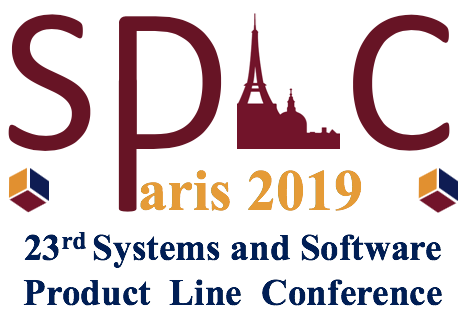The list of accepted tutorials in SPLC2019 is:
- Tutorial 1: Hugo Martin, Juliana Alves Pereira, Paul Temple and Mathieu Acher. Machine Learning and Configurable Systems: A Gentle Introduction.
- Tutorial 2: Mike Mannion and Hermann Kaindl. Software Reuse and Mass Customisation.
- Tutorial 3: Klaus Schmid, Holger Eichelberger and Sascha El- Sharkawy. Variability Modeling and Implementation with EASy- Producer.
- Tutorial 4: Juha-Pekka Tolvanen and Steven Kelly. Describing Variability with Domain- Specific Languages and Models.
- Tutorial 5: Maxime Cordy and Sami Lazreg. Automated Evaluation of Embedded-System Design Alternatives.
- Tutorial 6: Paul Clements and Charles Krueger. Feature-based Systems and Software Product Line Engineering: PLE for the Enterprise.
- Tutorial 7: Aitor Arrieta. Variability Modeling and Management of MATLAB/Simulink Models.
Tutorial 1: Hugo Martin, Juliana Alves Pereira, Paul Temple and Mathieu Acher. Machine Learning and Configurable Systems: A Gentle Introduction
The goal of this tutorial is to give an introduction to how machine learning can be used to support activities related to the engineering of configurable systems and software product lines. To the best of our knowledge, this is the rst practical tutorial in this trending eld. The tutorial is based on a systematic literature review and includes practical tasks (specialization, performance prediction) on real-world systems (VaryLaTeX, x264).
Tutorial 2: Mike Mannion and Hermann Kaindl. Software Reuse and Mass Customisation
This tutorial explores the impact of the socio-economic trends of mass customization on software reuse through software product line development.
Tutorial 3: Klaus Schmid, Holger Eichelberger and Sascha El- Sharkawy. Variability Modeling and Implementation with EASy- Producer
EASy-Producer is an open-source research toolset for engineering product lines, variability-rich software ecosystems, and dynamic software product lines. In this tutorial, we will introduce its (textual) variability modeling capabilities realized by the Integrated Variability Modeling Language (IVML) and its model-based development and implementation capabilities, which are realized by the Variability Instantiation Language (VIL) and the Variability Template Language (VTL).
Tutorial 4: Juha-Pekka Tolvanen and Steven Kelly. Describing Variability with Domain- Specific Languages and Models
This tutorial will teach participants about domain-specific languages and models, where they can best be used (and where not), and how to apply them effectively to improve the speed and quality of product development within a product line.
Tutorial 5: Maxime Cordy and Sami Lazreg. Automated Evaluation of Embedded-System Design Alternatives
This half-day tutorial presents a method to tackle the issue of evaluating a plethora of embedded system design-alternatives against functional and non-functional requirements. Our method results from a joint research project between three universities and Visteon Electronics, a multinational company active in the engineering of automotive embedded systems. We will illustrate its application on a real-world application and, first and foremost, under a practical prism. As such, practitioners developing embedded systems are invited to discover the capabilities of our techniques and tools, as well as insights on how to integrate them into their engineering processes. Moreover, researchers will get a comprehensive picture of the underlying techniques and the challenges that remain ahead.
Tutorial 6: Paul Clements and Charles Krueger. Feature-based Systems and Software Product Line Engineering: PLE for the Enterprise
This tutorial introduces a product line engineering solution, including tools and methods, that is the subject of an upcoming ISO standard and known as “FeatureBased Systems and Software Product Line Engineering.” This tutorial will explain the approach, give its history and a brief summary of some of its many successes, and discuss its application to systems and software engineering. Moreover, the tutorial will cover how its usage is spreading beyond the traditional engineering realm, across the entire enterprise in areas such as product marketing, portfolio planning, manufacturing, supply chain management, product service and maintenance, and much more.
Please contact Paul Clements <pclements@biglever.com> and Charles Krueger <ckrueger@biglever.com> directly to request the materials of Tutorial 6.
Tutorial 7: Aitor Arrieta. Variability Modeling and Management of MATLAB/Simulink Models
MATLAB/Simulink models are widely used in industry to model and simulate complex systems in several domains (e.g., automotive). These complex systems are produced in mass, and often, clients demand different functionalities. As a result, the variability of these models needs to be often considered. This tutorial aims at showing different variability modeling alternatives for MATLAB/Simulink users.
